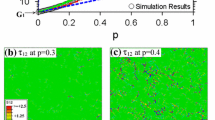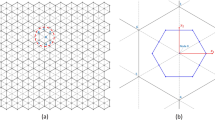Summary
In this paper we take a fresh look at the classical problem of Hill's arithmetic and geometric means. It is shown that both types of means can be derived from a dual class of polarization fields that lead to an “ordered” structure. Hill's arithmetic mean of Voigt's and Reuss' moduli is derived from the displacement-prescribed boundary condition, whereas the arithmetic mean of the compliances is derived from the traction-prescribed condition. These means are found to correspond to 1/4-th of the maximum elastic energy from the perturbed elastic field, the maximum values being associated with the Reuss and Voigt approaches, respectively. Hill's geometric mean, on the other hand, always lies between this pair of moduli. It also represents the limiting case of the arithmetic means for this class of ordered materials that can be constructed with a hierarchical scheme. Despite their simplicity, both the arithmetic and the geometric means are found to fully meet the rigorous requirement for the shift property of the effective moduli recently derived by Hu and Weng [10].
Similar content being viewed by others
References
Voigt, W.: Über die Beziehung zwischen den beiden Elastizitätskonstanten isotroper Körper. Ann. Phys.38, 573–587 (1889).
Reuss, A.: Berechnung der Fließgrenze von Mischkristallen auf Grund der Plastizitätsbedingung für Einkristalle. Z. Angew Math. Mech.9, 49–58 (1929).
Hill, R.: The elastic behavior of a crystalline aggregate. Proc. Phys. Soc.A 65, 349–354 (1952).
Kröner, E.: Graded and perfect disorder in random media elasticity. J. Engng Mech. Div., ASCE,106, 889–914 (1980).
Eshelby, J. D.: The determination of the elastic field of an ellipsoidal inclusion, and related problems. Proc. R. Soc. LondonA 241, 376–396 (1957).
Walpole, L. J.: On bounds for the overall elastic moduli of inhomogeneous systems-I. J. Mech. Phys. Solids14, 151–162 (1966).
Hill, R.: Elastic properties of reinforced solids: some theoretical principles. J. Mech. Phys. Solids11, 357–372 (1963).
Hill, R.: Continuum micro-mechanics of elastoplastic polycrystals. J. Mech. Phys. Solids13, 89–101 (1965).
Hashin, Z., Shtrikman, S.: A variational approach to the theory of the elastic behaviour of multiphase materials. J. Mech. Phys. Solids11, 127–140 (1963).
Hu, G. K., Weng, G. J.: A new derivative for the shift property of effective elastic compliances for planar and three-dimensional composites. Proc. R. Soc. LondonA457, 1675–1684 (2001).
Author information
Authors and Affiliations
Rights and permissions
About this article
Cite this article
Chiang, C.R., Weng, G.J. A new look at Hill's arithmetic and geometric means for a two-phase, isotropic composite. Acta Mechanica 156, 1–12 (2002). https://doi.org/10.1007/BF01188738
Received:
Issue Date:
DOI: https://doi.org/10.1007/BF01188738




